South Molton, Devon
Up to 1834
The first Workhouse in South Molton was situated in North Street, a little above the front entrance to the Junior School, near to where Alexandra Terrace now stands. It was opened in 1735 'for receiving all the poor who had pay of the parish' — about 104. The House was rented from a Mr Richard Gay at £11.10.0d per annum.
The second was on the site of the old Vicarage in Parsonage Lane where a disastrous fire took place in 1837. On a Sunday afternoon at the end of May the alarm was raised in the Parish Church, by a member of the congregation, just as a service was about to start. Ninety confused inmates and staff were taken to the Town Hall and other convenient buildings while men, many wearing their Sunday best clothes, helped to tackle the blaze. The building was destroyed but fortunately it was insured for £300 and no one is reported as having been injured.
North Molton had a workhouse from around 1741 (Hitchcock, 1985).
A parliamentary report of 1777 recorded parish workhouses in operation at Chittlehampton (for up to 40 inmates), Chulmleigh (36), Knowstone (28), North Molton (45), South Molton (100).
Chittlehampton's workhouse stood on The Square, where Chittlehampton Primary School now stands.
Witheridge, one of the parishes later to form part of the South Molton Union, had a village poorhouse. After the opening of the Union workhouse in South Molton, it was pulled down to make way for the then new turnpike road to enter the village.
After 1834
South Molton Poor Law Union formally came into existence on 28th November 1835. Its operation was overseen by an elected Board of Guardians, 36 in number, representing its 29 constituent parishes as listed below (figures in brackets indicate numbers of Guardians if more than one):
Devon: East Anstey, West Anstey, Bishop's Nympton, East Buckland, West Buckland, Burrington, Charles, Cheldon, Chittlehampton, Chulmleigh, Creacombe, Filleigh, George Nympton, King's Nympton, Knowstone, Molland, Mari-Ansleigh [Mariansleigh], Meshaw, Molland, North Molton, South Molton, Rackenford, Romansleigh, Rose Ash(e), Satterleigh, Twitchen, Warkleigh, Witheridge, East Worlington, West Worlington.
Later additions: Chittlehamholt (from 1866), Queensnympton (from 1894).
The population falling within the union at the 1831 census had been 18,873 — ranging from Creacombe (population 43) to South Molton itself (3,826). The average annual poor-rate expenditure for the period 1833-35 had been £8,619 or 9s.2d. per head
The new South Molton Union workhouse, believed to have been designed by Sampson Kempthorne, was erected in 1837-38. Built of stone, at a total cost of £4379 (including £3,714.16.10d for the construction work) it could accommodate 230 inmates. The building was sited 'in a healthy spot' on the west side of North Road (subsequently known as Union Road) at the north-west of the town. The workhouse location and layout are shown on the 1903 map below:
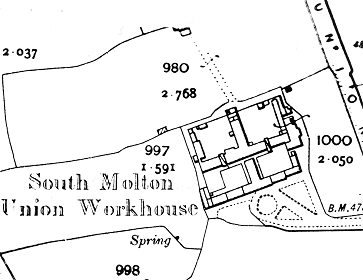
South Molton site, 1903.
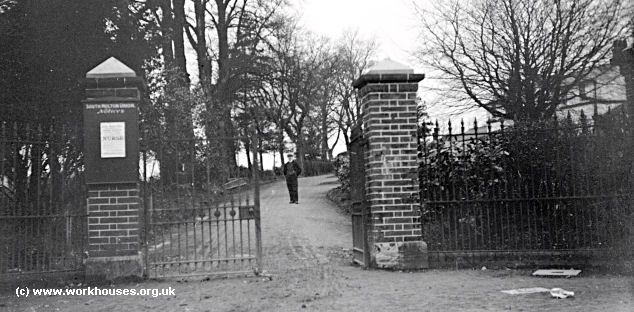
South Molton entrance gates, c.1900.
© Peter Higginbotham.
The design was based on Kempthorne's "200-pauper" plan and consisted of a T-shaped entrance block which contained the Guardians' board-room. Behind this, the wings of a further T-shaped block provided separate accommodation for the different classes of inmate (male/female, old young etc.)
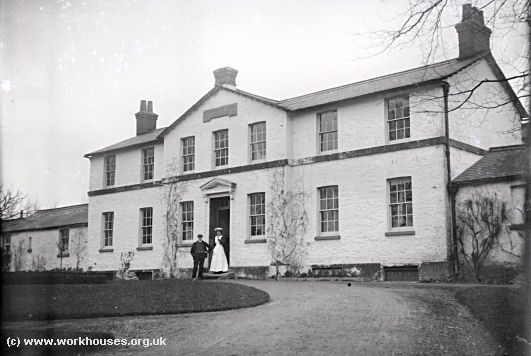
South Molton entrance block from the south-east, c.1900.
© Peter Higginbotham.
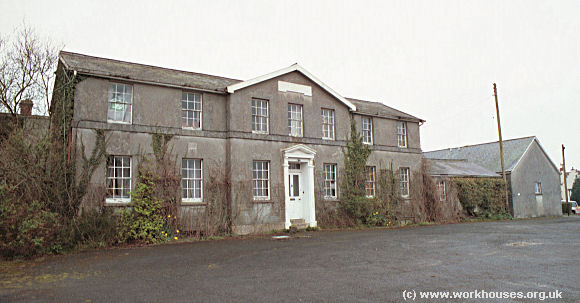
South Molton entrance block from the south, 2001.
© Peter Higginbotham.
The Poor Law Amendment Act placed emphasis on workhouses for work rather than caring for the elderly. There was no classification of the sick, and the chronically disabled were classed with the insane. Aged paupers gradually formed an increasing percentage of the occupants — 70% by the 1870s countrywide. From the 1840s workhouses were allowed to provide surgical and medical attendance and in 1843 another storey was added to the South Molton workhouse in order to provide a sick ward.
The 1851 census carried out in South Molton tells us that Thomas Redler aged 43 was the Governor of the Union House. Other staff were, Susan Hamilton, Matron, Edmund Higby, Schoolmaster, Matilda Drake, Schoolmistress, Richard Chapple, Porter and Mary Widgery, Nurse. There were 133 inmates, all of whom were classified as paupers and whose ages ranged from a 3 week old baby, (Walter Sanders), to a 90 year old man (Thomas Nicholls). Over half of the population of the Workhouse were children, there being 77 under the age of 16 years. Many of the children were classified as scholars the youngest of these being aged 3 years and the eldest 15 years.
Twenty years later, the census of 1871 reveals that the numbers of staff had increased to seven and the numbers of inmates had dropped to 85. John Mills is named as Master of the Workhouse, Mary Mills, his wife, was a school mistress. Lucy and Ellen Churchill, sisters-in-law to John Mills are named as school mistress and assistant school mistress respectively, Mary Dunham was Matron, Elizabeth Thorne, Nurse and John Huxtable, Porter.
The youngest inmate at this time was 9 months and the oldest 91 years. There were two infants aged 0-2 years, with 35 children aged 3-15 years, and 31 men and 17 women over the age of 16 are recorded. Eight of the inmates are classified as Idiot from birth. The former occupations of the inmates included: agricultural labourer, domestic servant, carpenter, navvy, gardener, farmer, farm servant, maltster, mason, woolcomber, coachman, dressmaker and a nurse.
J. E. Cutliffe, a Surgeon and one of the Medical Officers of the Southmolton Union speaking on the apprentice system in a Report of Special Assistant Poor Law Commissioners & The Employment of Women and Children in Agriculture 1843 stated that:
On the morning of Saturday 19th November 1891 a fire was reported at the South Molton Union Workhouse which tragically resulted in the deaths of three inmates with several others being injured. John Cock, who recorded the event in 1893 states that: 'Of all the public buildings in South Molton, the Union House would have appeared as the one least likely to be destroyed by fire. In any ordinary case there was nothing to burn — the doors, windows, and flooring appearing to be all that was available'. The cause of the fire was a petroleum lamp, described at the time as 'a lamp of a most objectionable make'. The lamp broke into two pieces — the oil escaped and caught fire, burning a tablecloth and matting laid on the floor, and within a very few minutes the lives of a dozen people were at risk. More people might have perished but for the prompt arrival on the scene of Police Constable Wotton who, with the help of an inmate named John Wise, managed to rescue those in immediate danger. Luckily, the local fire-engines were quickly on the spot and the fire was extinguished.
Both P.C. Wotton and John Wise received public recognition of their bravery — P.C. Wotton was presented with £5 from the Royal Society for the protection of Life from Fire. The Society also presented a Certificate and £1 to Wise. The townspeople collected £14 with which a marble clock and a silver watch with gold chain and pendant was purchased and presented to P.C. Wotton together with a book containing the subscribers' names.
No repairs were made to the part of the House that had been damaged by the fire until 1895-6, when the whole of the north wing was rebuilt and gas lighting was installed. These were the only structural alterations of any consequence made to the building until 1950 when the building was modernised and it became a welfare home for the elderly. Until this time it had remained very much as it had been in the days of Charles Dickens.
The Workhouse was administered by the South Molton Board of Guardians. Viscount Ebrington was the Chairman of the Board during the last decade of the 19th century. At a meeting in May 1896 it was resolved on the motion of Lord Ebrington "that if a child goes out to service from the Workhouse within three months of having a new pair of Boots such child shall not have a new pair on leaving, but if after three months there, that a new pair be given in addition to the old ones."
Another glimpse into life at the Workhouse is contained in a Guardians report later that same year when it is recorded that "In consequence of an entry in the Chaplains Book respecting the illness of Alice Foreacre, an inmate of the Lying in Ward, it was resolved to have the regulations as regards sending for the Chaplain in cases of Paupers illness printed and hung in the different Wards in the Workhouse."
An interesting account of one of the Board Meetings is given in the South Molton Gazette dated September 6th 1902. Dr. Wigham, the Medical Officer, was summoned before the Board because he had written a report which stated that a Chittlehampton man named John Greenslade aged 83 was in a state of starvation. The chairman told the Medical Officer that they felt that the circumstances of the case did not justify such an entry. Dr. Wigham explained that the word 'starvation' should not have been taken literally. It did not mean that the person was really dying for want of sustenance. There was plenty of food, but not the right sort that old people required. He went on to say that the Board should not assume that any reflection was made as to their liberality, as he knew from experience that they were the most liberal Board in the country, and never refused to help in a deserving case. He admitted that the word 'starvation' looked rather stark and staring but that had he used the medical term it would not have appeared so harsh, but, at the same time, it would have had the same meaning. The Medical Officer was told that it was felt that he had been a little indiscreet in using the word 'starvation' and Dr. Wigham was asked 'You don't accuse this Board of not allowing sufficient relief to prevent the man from starving?' Dr. Wigham replied, 'No, not for a moment'. The Medical Officer assured the Board that no discredit was intended and the subject was dropped.
At the same Board Meeting, the Master reported that there were 63 inmates in the House as against 57 the previous year and that 24 vagrants had received relief during the previous two weeks. The Board acknowledged, with thanks, gifts of periodicals to the inmates, from Mr H. Turner and members of the Constitutional Club; and tracts from 'Anonymous'.
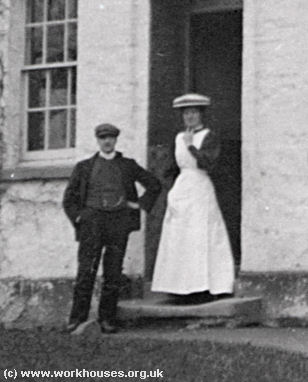
South Molton workhouse staff, c.1900.
© Peter Higginbotham.
A good account of living conditions at the Workhouse is given in a Report written by Mr W. Branthwaite, Commissioner of the Board of Control, after his visit on September 26th, 1917. The Report had been written with reference to the proposed admission of Mental Defective Patients to the South Molton Workhouse and was read out at a meeting of the Board of Guardians held on Thursday October 25th 1917.
Mr Branthwaite reports that:
This is quite a nice, little workhouse, in a good situation, bright, with well kept gardens, and generally well found. The buildings are fairly old, but are well constructed and have been comfortably furnished, and fitted with many modern conveniences. The body of the house will hold some 30 to 40, and the infirmary 12, of each sex, possible space for some 85 to 100 inmates. At the time of my visit there were 16 men and 25 women in residence — a total of 41.
The buildings are so arranged that a complete block containing a day room, dormitory, yard, washhouse and bathroom, can be assigned to feeble-minded cases on both sides of the Institution. These blocks are similar in design, and will each hold ten patients, i.e. ten males and ten females — 20 in all. The day room on the female side is decently lighted and has a wood floor covered by matting but that on the male side is not so satisfactory in these respects.
The two windows on the south wall of this room should be enlarged, made to give a larger opening for ventilation and the stone or cement floor covered with matting. These in fact are the only necessary alterations before approval. The dormitories are good, and properly provided with fire exits. The sanitary arrangements are modern, and the baths all that could be desired, and provided with key taps.
The yard is of useful size and would serve the purpose all right of the exercise and airing of cases unable to engage in occupation. Some day the removal of an unnecessary wall running parallel to the building would make it larger and more open, but this is not essential.
Patients would feed in the general dining room, a sufficient number of tables being assigned to them, and sick cases would be treated in the Infirmary. For these reasons and because there may be cases in good health suitably dealt with in other parts of the Institution, I suggest it would be better to approve the whole premises for 10 males and 10 females, on the understanding that the two blocks shown to me should be used for Mental Deficiency cases as much as possible. This course seems to me desirable in order that some rough classification may be possible. The restriction of the approval to the blocks indicated would mean that no separate treatment would be possible except as regards sex. Moreover it will certainly be found that some patients will require constant nursing and therefore benefit by permanent residence in the infirmary.
The Workhouse staff consists of master, matron, assistant matron, nurse, laundress, porter and gardener. At the moment the Master is away on military service, but the Matron impressed me as being thoroughly capable and efficient. I was given to understand that, if the place is approved and occupied, such additional help as is necessary will be obtained.
The house is lighted with gas, supplied with water from the town mains, and the drainage is connected with the town system. The kitchen arrangements are good, and steam cookers are fitted. There is a small church connected with the Workhouse, service being held every Sunday afternoon. A branch of the Brabazon Society interests itself in the employment of inmates, and arrangements are regularly made in the town for inmates to attend any shows, concerts, or amusements that visit. I was given to understand that these facilities would be extended to mental deficiency cases.
The Local Government Board Inspector, Mr E.D. Court, stated after the Report had been read, that the House had always been well kept up, and he said that he was glad to see that the Guardians had made provision for the comfort of two blind inmates. In the sick wards everything was clean and tidy. He said that due to the removal of tramps from the North Devon district and the closure of the casual wards four months previously, there might be a shortage of labour in the Spring and they would probably have to hire labour for the garden, as they would not be able to rely on casuals being admitted. He went on to say that provisions in the House were generally satisfactory, especially the bread and milk.
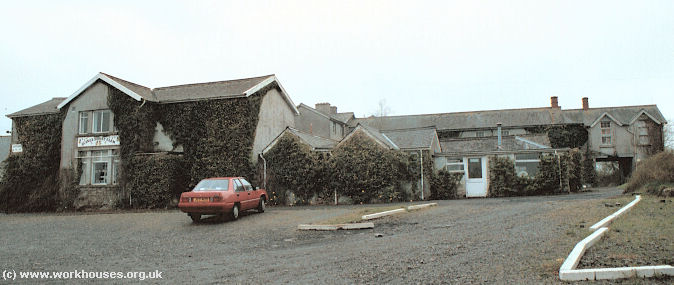
South Molton from the north-east, 2001.
© Peter Higginbotham.
When the Local Government Act 1929 came into force, the South Molton Board of Guardians (Guardians of the Poor) handed the building over to the Devon County Council. The Council painted it 'green and cream'. At this time the building was used to house the aged, aged sick, mental defectives, de-certified mental defectives, vagrants and casuals ('tramps'), persons of sub-normal mentality, the poor, the outcast and the unwanted. The 'Infirmary' part of the 'Poor Law Institution' was used as a chronic sick hospital for both sexes.
The Master's Report written in March 1939 records that:
- The number in the House is 29 men and 44 women (an increase of 8 over the corresponding day of the previous year). Casuals during the month were men — 255 and women — 8.
- Three pigs had been sold to Mrs. Clarke, Butcher, South Molton.
- Dr MacKay, the Commissioner of the Board of Control had visited the Institution and had seen all the defective patients.
- The Committee were asked to sanction the payment of £4:10:0d for fire bars supplied by Messrs. Sanders & Sons.
The Masters Day Book showed the following expenditure:
- Provisions £74:17:3
- Necessaries £34:6:4
- Farm Garden £2:0:4
- Drugs £4:14:8
- Building Repairs £127:9:7
The Master reported that a telephone was needed from the casual ward to the House in case of emergency either by day or night. He also requested that the Committee 'kindly advertise for 2 tons of eating potatoes and appoint a small committee to open tenders and accept.'
The Workhouse contained a Chapel where weekly services were held and below is a report written by the Minister on the 25th March 1942:
My duties began with the mid-week evening service on September 11th 1941. After several weeks, war-time conditions made it necessary for the weekly services to be held in the afternoons; and throughout the past winter, with 3 exceptions, I have conducted the services... I count it a great privilege, and responsibility to be allowed to minister to the inmates of the House in spiritual things; and consider that the interest displayed in the weekly services is evidence of good work being done.
Signed: Stanley P. Bowers
The Master reported in November 1948 that the harmonium in the Chapel was completely worn out and that a new instrument was required. He suggested that a sub-committee be appointed to meet Mr Lyddon 'who is competent to make suggestions as to what is most suitable to meet the requirement'.
On the 5th July 1948, the National Health Service came into operation. Under Section 21 (1)(a) of the National Assistance Act 1948, the workhouse — now known as Beech House — was to provide accommodation 'for persons who, owing to age, infirmity, or other circumstances are in need of care and attention which is not otherwise available to them.' During the years 1950-1956 a transformation took place. The rough stone walls were plastered, the prison like windows replaced by large steel ones and the rooms were decorated in bright colours with curtains to match. New warm bathrooms were provided and the grim workhouse furniture was replaced by something more comfortable (although the residents continued to sleep in dormitories until the 1970s). Unnecessary rules and regulations ceased and the residents were free to come and go as they wished and to take part in community life.
The entry in the Master's Report Book dated January 27th 1949 records that 'the Christmas Dinner was attended by many friends among whom were the Chairman Mr F.J. Loosemore, who very kindly gave every patient a 2/- piece and Mrs. Roy Snell gave a large bottle of sweets and Mr A.C. Chanter Mince Pies.'
A New Years tea and entertainment was held on 24th January 1949 when Mrs. Cross and members of the Girls Training Corp 'again delighted their audience with a very clever and interesting programme... The Mayor and Mayoress honoured us with their presence at both occasions.'
The residents at this time numbered 44 men and 25 women.
By 1949 the title of 'Master' had been replaced by 'Superintendent' and the last entry in the Report Book is dated April 5th 1949 and records as follows:
'Mr & Mrs Hickman and family arrived in South Molton on 28th March 1949. The new Superintendent and Matron 'took over' from Mr & Mrs Webber on the afternoon of Thursday 31st March and commenced official duties on the morning of Friday 1st April.
First impressions good, but priority No. 1 appears to be additional staff; together with an improved diet for officers, residents and patients.
No. in House
43 men + 24 women (67)
27 sick — 40 non-sick (67)
Signed F.J. Loosemore Chairman 5/4/49'
Beech House took its name from an old beech tree which stood in the grounds for over a hundred years until it was damaged during the gales of March 1955. In November 1955 a new copper beech, given by Mr H. Harris of Goodleigh, was planted in the same spot by the Matron, Mrs. Amy Hickman. At the ceremony, the Chairman of the Welfare Committee of Devon County Council, Col. Rowland Ward, said 'Beech House was built as a Workhouse in 1837, but it serves a completely different purpose today. The committee was delighted with the great changes that had taken place since 1948. Other old institutions had been taken over and were still in an unchanged state, but through the hard work of the committee, Beech House had been entirely transformed from its original purpose and was now a model welfare home, which when a reconstruction scheme was completed, will be one of the finest in Great Britain.'
The Superintendent, Mr W. Hickman, said afterwards that the structure of the building was being considerably altered so as to turn it into a modern welfare home with accommodation for 103 people. At this time it was accommodating 89.
The old Workhouse fell into disuse in the mid 1970's when a new purpose built residential home for the elderly was built by Devon County Council. The new building of red brick has retained the name of Beech House and is situated to the left of the old Workhouse in North Road. The old Workhouse buildings were bought by George Wallace in 1978 and converted into a honey farm and it is now one of the top tourist attractions in the area. The former chapel is used as a shop for selling souvenirs and products produced at the honey farm.
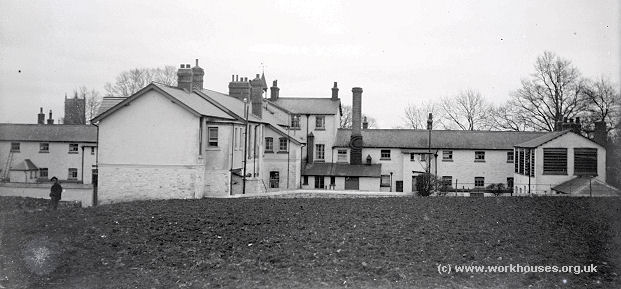
South Molton from the north, c.1900.
© Peter Higginbotham.
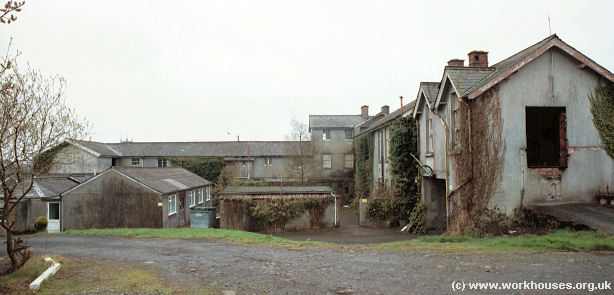
South Molton from the north, 2001.
© Peter Higginbotham.
Children's Home
In the early 1900s, the South Molton union established a home for pauper children at41 East Street, South Molton. It could accommodate 40 children. The property is now a private residence.
Staff
Inmates
Records
Note: many repositories impose a closure period of up to 100 years for records identifying individuals. Before travelling a long distance, always check that the records you want to consult will be available.
- North Devon Record Office, Tuly Street, Barnstaple, EX31 1EL. Relatively few local records survive — holdings include: Guardians' minute books (1895-8, 1911-20); Committee minutes (1888-1927).
Bibliography
- Cock, J (1893) Records of the Ancient Borough of South Molton
- Gentry, FD (1985) Take care of your Fire and Candle
- Hitchcock, T.V. (1985) The English workhouse: a study in institutional poor relief in selected counties. l695-l750. (DPhil thesis. University of Oxford.)
- Mills, J (1892) History of South Molton
- Health & Welfare Services (Devon County Council paper)
- Health in a North Devon Parish in the 19th Century (paper by John Usmar)
- South Molton Gazette
Links
- None.
Acknowledgement
The bulk of the material on this page was researched and written by Shirley Bray of South Molton. Her very kind permission in allowing her work to be included here is gratefully acknowledged.
Unless otherwise indicated, this page () is copyright Peter Higginbotham. Contents may not be reproduced without permission.


